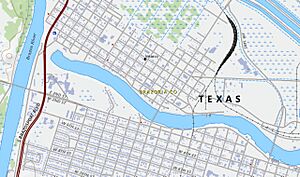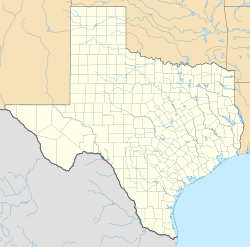Velasco, Texas facts for kids
Quick facts for kids
Velasco, Texas
|
|
|---|---|
|
Ghost Town
|
|
Nickname(s):
|
|

Velasco in Brazoria County, Texas
|
|
| Country | United States |
| U.S. State | Texas |
| County | Brazoria County |
| Incorporated Town | Freeport |
| Founded in Mexican Texas | 1821 |
| Founded by | Old Three Hundred |
| Time zone | UTC-6 (Central (CST)) |
| • Summer (DST) | UTC-5 (CDT) |
| ZIP code |
77541
|
| North American Numbering Plan | 979 |
| GNIS feature ID | 1381075 |
Velasco was a historic town in Texas, United States. It was located on the east side of the Brazos River, close to the Gulf of Mexico. In 1957, Velasco joined with the nearby city of Freeport after a vote by the people living in both towns.
Velasco was founded in 1831 and played a big part in the early history of Texas. It was a key entry point for American settlers coming into Texas. The town is famous for the Battle of Velasco and its connection to the Texas Revolution. After Texas won its independence, Velasco even served as the temporary capital of the Republic of Texas in 1836.
Contents
History of Velasco
Velasco was first located right on the Gulf Coast, near where the Brazos River meets the sea. This area is now called Surfside.
Early Settlers and Growth
In 1821, a ship named Lively arrived at this spot. It carried 38 men, who were the first settlers brought by Stephen F. Austin. At that time, Texas was part of Mexico. Austin had permission to bring American families to settle the land. These first colonists made their homes in what is now southern Brazoria County.
For a while, Velasco was just one house. But in 1831, Mexico opened a customs port there. They sent soldiers to help collect taxes on goods. More than 25,000 settlers entered Texas through this port. The town was named after a Mexican general.
The Battle of Velasco
Velasco was the site of an important fight called the Battle of Velasco in 1832. This battle happened four years before the main Texas Revolution. On June 26, 1832, Texas colonists fought against Mexican soldiers.
The Mexican commander, Domingo de Ugartechea, tried to stop the Texans. The Texans were moving a cannon up the Brazos River to attack the city of Anahuac. The Texans were led by John Austin and Henry Smith. After three days of fighting, the Texans won. The Mexican soldiers ran out of ammunition, and Ugartechea surrendered.
Temporary Capital of Texas
In 1834, a sickness called cholera caused the town's population to shrink to only 100 people. However, Velasco's importance grew after the Battle of San Jacinto. After this battle, Texas won its independence from Mexico.
The interim President of the new Republic of Texas, David G. Burnet, made Velasco the temporary capital. Important government papers were kept at Fort Velasco. On May 14, 1836, Mexican General Antonio López de Santa Anna signed the Treaties of Velasco here. These treaties officially recognized Texas as an independent nation.
Life Before the Civil War
Before the American Civil War, Velasco and the town across the river, Quintana, were popular summer vacation spots. Wealthy families from nearby plantations would visit. Businessmen like Samuel May Williams and Thomas F. McKinney set up warehouses and shipping services at the port.
By 1838, Velasco had schools for both young ladies and young men. There were also nice hotels for visitors and a racetrack nearby. A local post office operated from 1846 to 1891. Velasco had businesses, homes, hotels, and a customs house. Steamboats traveled from its docks to Galveston and New Orleans. However, when a canal to Galveston Bay was finished in 1856, some of Velasco's shipping business moved to Galveston.
During the U.S. Civil War
During the American Civil War, Confederate soldiers built defenses at Velasco's port. They had eight gun batteries. This made it hard for Union ships to get supplies. The port was important for trading cotton for European guns, ammunition, and medicines for the Confederate army. Union ships tried to stop this trade, often firing at the shore defenses.
After the Civil War
After the Civil War, the plantation system was ruined. This caused Velasco and Quintana to decline as resorts. In 1875, a hurricane destroyed many of the old town records. By 1884, only about 50 people lived in Old Velasco.
New Velasco Develops
In 1891, a new town of Velasco was planned and built about four miles upriver. A new post office was opened there. On July 7, 1891, the port was officially opened by the United States Secretary of the Treasury, William Windom. Many people from the Midwest bought land in New Velasco, hoping for a better life by the sea.
By 1892, New Velasco had many businesses, homes, an electric light plant, and a wood planing mill. Jetties (structures that protect a harbor) were built by 1897, making the port deep enough for large ships.
Much of Velasco was later sold to an agent for the English Rothschild family. They hoped to create a major seaport there. By 1896, the community had a new lighthouse, churches, schools, hotels, a bank, and two weekly newspapers. You could even reach Old Velasco and Crescent Beach by electric railroad.
The 1900 Galveston Hurricane and Recovery
The town's population reached 3,000 when the terrible Galveston hurricane of 1900 hit and destroyed much of Velasco. The town rebuilt slowly, going through good times and bad. By 1914, the population was 1,000. The town had a fish and oyster plant and shipped cattle, cotton, and sugar.
During the Great Depression in the mid-1930s, the population dropped to 400. Only 12 businesses remained.
River Changes and World War II
The port of Freeport had been built four miles upstream on the Brazos River. The river below Freeport needed to be constantly dug deeper for bigger ships. In 1929, the U.S. Army Corps of Engineers changed the course of the Brazos River. They moved it three miles to the west. This left the old four-mile section of the river as a separate ship channel.
This change to the Brazos River helped both Velasco and nearby Freeport. During World War II, new chemical factories were built, creating many jobs. Velasco's population grew from 900 in 1940 to 5,200 by 1950. In 1940, Velasco officially became a city, with E. F. Roeller as its mayor.
Finally, with about 4,000 people in 1956, Velasco officially joined with Freeport on July 27, 1957. The area then became part of the larger Brazosport industrial and port region.
Gallery
See also
 In Spanish: Velasco (Texas) para niños
In Spanish: Velasco (Texas) para niños




